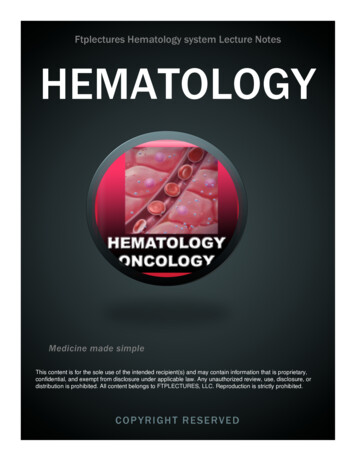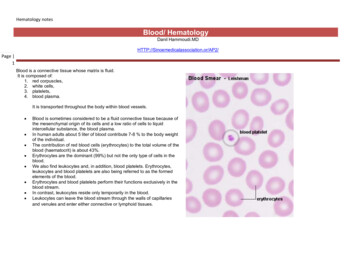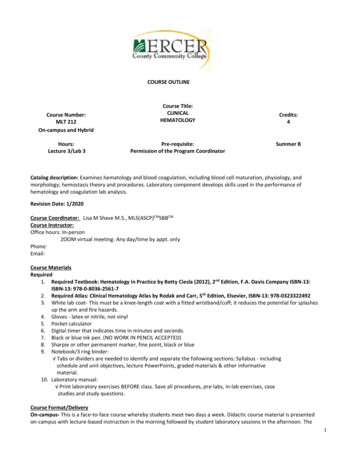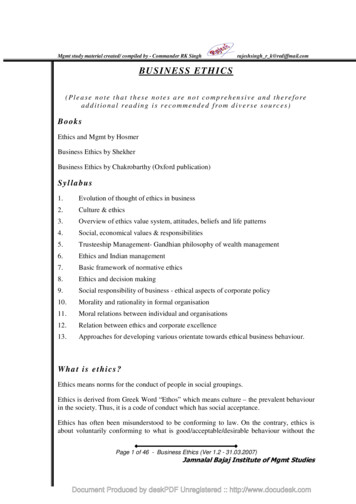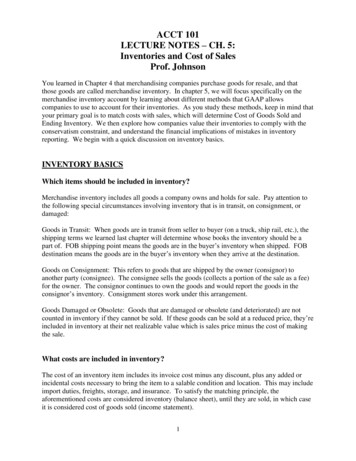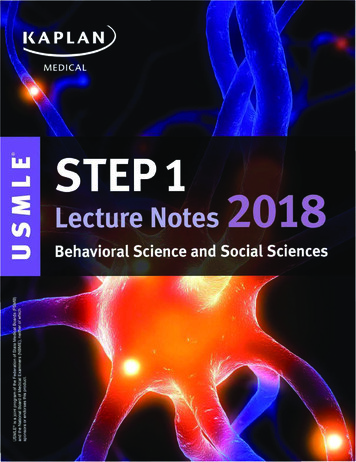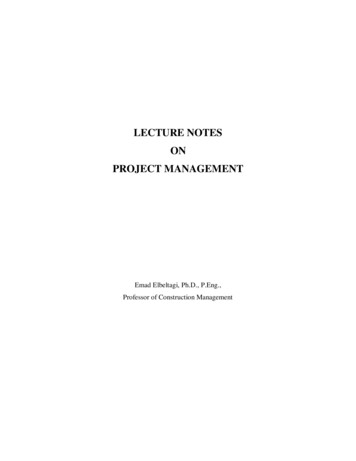
Transcription
Lec 01: HematologyAssist. Prof. Dr. Mudhir S. Shekha3rd Medical AnalysisTishk International University
Introduction, short history, role of blood,composition of blood Hematology: the study of the physiology of the blood Hematology: is the branch of medicine concerned with the study of the cause,prognosis, treatment, and prevention of diseases related to blood. Hematology is the science or study of blood, blood-forming organs, and blooddiseases. Blood: Nutritive fluid that circulates through the circulatory system to supplyoxygen and nutrients Blood is a fluid connective tissue, a variety of specialized cells that circulate in awatery fluid containing salts, nutrients, and dissolved proteins in a liquidextracellular matrix. Blood contains formed elements derived from bone marrow
History of Blood 1288: Small Circulatory System by Ibn Alnafis 1492: The first reported blood transfusion occurred (three healthy individuals toPop Innocent VII). 1578: Large Circulatory System by William Harvey 1628: William Harvey, an English physician discovered how blood circulated 1665: The first successful blood transfusion was recorded (dog toanother). 1666 : RBC by Marcello Malpighi 1667: Richard Lower and Jean-Baptiste Denis reported successfultransfusions from animals to humans. 1795: Syng Physick did the first successful blood transfusion from onehuman to another human in America. 1818: The first successful transfusion was recorded (husband to his wife) 1843: WBC by Gabriel Andral 1882: Platelets by Giulio Bizzozero 1899: Leukemia by Maj. Samuel T. Armstron
1900: Karl Landsteiner three human blood groups 1902: Two students ABO blood group system. 1903: George Washington Crile started to use blood trasnfusionregularly in surgery. 1909, cross-matching of blood. 1910: Anemia noted by Herrick 1912:Roger Lee defined the terms ‘Universal donor’ and‘Universal recipient 1914: As mentioned earlier, several anticoagulants 1916:Francis Rous and J.R. Turner introduced a citrate-glucosesolution, which was added to the collected blood. 1925:While Karl Landsteiner was working in New York hediscovered two more blood group systems, the MN and the Pblood group systems. 1926: The British Red Cross instituted the first human bloodtransfusion service in the world.
Functions Transports– Dissolved gases (e.g. oxygen, carbon dioxide)– Waste products of metabolism (e.g. water,ammonia, urea, uric acid, and creatinine, Lacticacid.)– Hormones– Enzymes– Nutrients (such as glucose, amino acids, micronutrients (vitamins & minerals), fatty acids,glycerol)– Plasma proteins (associated with defence, such asblood-clotting and anti-bodies)– Blood cells (incl. white blood cells , and redblood cells ).
Maintains Body Temperature body temperaturenormally fluctuateswithin a degree of37.0 C (98.6 F).Maintainingappropriate bodytemperature byabsorbing anddistributing heatthroughout the bodyand to the skinsurface toencourage heat loss.
Controls pH Maintaining normal pH in body tissues. Many blood proteinsand other bloodborne solutes act as buffers to prevent excessive orabrupt changes in blood pH that could jeopardize normal cellactivities. Additionally, blood acts as the reservoir for the body’s“alkaline reserve” of bicarbonate atoms. The pH of blood mustremain in the range 6.8 to 7.4, otherwise it begins to damagecells.(Acid-base Balance)
Removes toxins from the body The kidneys filter all of the blood in the body , 36 times every24 hours. Toxins removed from the blood by the kidneys leavethe body in the urine. (Toxins also leave the body in the form ofsweat.)
Regulation of Body FluidElectrolytes Maintaining adequate fluid volume in the circulatory system. Salts(sodium chloride and others) and blood proteins act to preventexcessive fluid loss from the bloodstream into the ECF. As a result, thefluid volume in the blood vessels remains ample to support efficientblood circulation to all parts of the body
Preventing blood loss. When a blood vessel is damaged, platelets and plasma proteinsinitiate clot formation, halting blood loss. Preventing infection. Drifting along in blood are antibodies, complement proteins, and whiteblood cells, all of which help defend the body against foreign invaders such as bacteria andviruses.
Composition of Blood If blood is spun in a centrifuge, 3 layers are formed:1. Bottom Layer ( 45%)- The heavier formed elements are packeddown by centrifugal force. Most of the reddish mass at the bottom is erythrocytes (RBCthat function in O2 transport).2. Top Layer (55%)- The lighter plasma rises to the top3. Buffy Coat ( 1%) - Thin, whitish layer between the formedelements layer and the plasma layer. Contains Leukocytes & Platelets
HEMATOPOIESIS hematopoiesis or hemopoiesis is the formation of bloodcells ( red blood cells, white cells, and platelets (bloodcell formation)). Hemopoietic organs are bone marrow, thymus, lymphnodes and lymph follicles, spleen and liver. Hematopoiesis occurs in the red bone marrow especially: Axial skeleton and girdles Epiphyses of the humerus and femur Hemocytoblasts give rise to all formed elements
The cellular pathways ofhematopoiesis: cellular Organization of Hematopoiesis 1. Stem Cells: Totipotential. Multipotential.2. Progenitor Cells.3. Precursor Cells.4. Effector Cells.
Stem Cell These cells have extensive proliferative capacity Totipotent Stem Cells Self Renewal, Pluripotency, Present in Marrow in SmallNumbers, Highly Resistant to Chemotherapy, Small numberscirculate in blood, Surface Antigen -CD34 and Dysfunctionleads to aplastic anemia or certain types of leukemiaQ/ What arehemopoieticmicroenvironment?
Multipotent Stem Cells (Lymphoid andMyloid) Produced from Totipotent Stem Cells Able to self renewal, Differentiation(Ex:Lymphoid Mature Lymphosyte) Lymphoid stem cell Lymphoproliferative Acute Lymphocytic lukemia) Myeloid stem cell ?
Progenitor Cell (CFU) Derived from Multipotent Committed stem cells lose theircapacity for self-renewal (limited). It is irreversibly committed Regulated by hormone or substanceto Proliferation and Maturation. CFU-GEMM, CDU-GE, CFU-GM, CFU-G
Precursor Cells -Blasts andtheir progeny First morphologically identifiable cells: Erythroblast -Red Cells. Myeloblast -Granulocytes. Monoblast –Monocytes. Lymphoblast –Lymphocytes. Megakaryoblast –Platelets. Little if any self-renewal. The cellular pathwaysof hematopoiesis:
Mature Effector Cells Red Cells: carry oxygen, carbon dioxide;lifespan 120 days. Neutrophils: phagocytosis, killing. Lymphocytes: identify cells as self or nonself. Monocytes: phagocytosis, killing, antigenpresentation. Platelets: hemostasis. The cellular pathwaysof hematopoiesis:
Prenatal and neonatal hemopoiesis Progressive hemopoiesis in these organs results fromin situ differentiation of circulating stem cells. The liver and spleen are inactive but retain potentialto revert to hemopoiesis in diseases of bone marrow
Hematology: is the branch of medicine concerned with the study of the cause, prognosis, treatment, and prevention of diseases related to blood. Hematology is the science or study of blood, blood-forming organs, and blood diseases. Blood: Nutritive fluid that circulates through the circulatory system to supply oxygen and nutrients Blood is a fluid connective tissue, a variety of .
